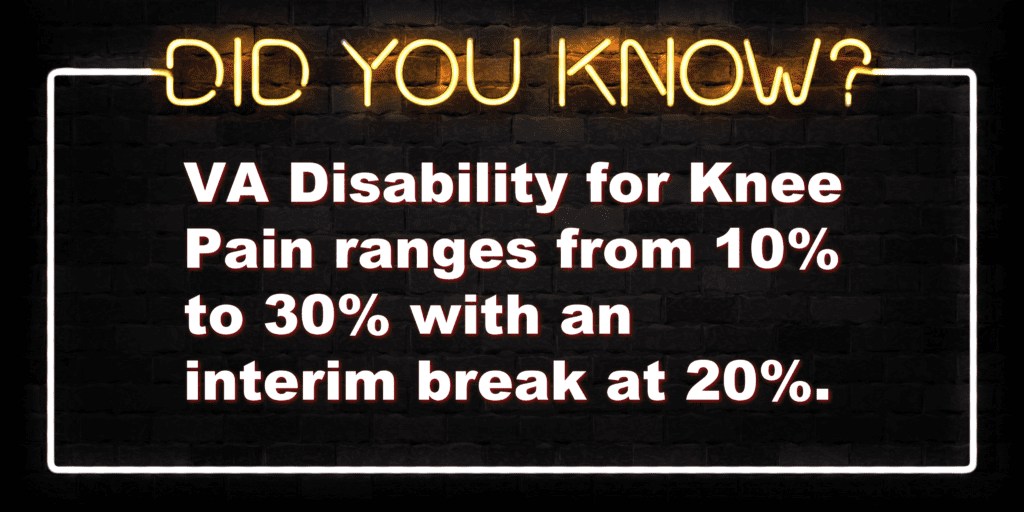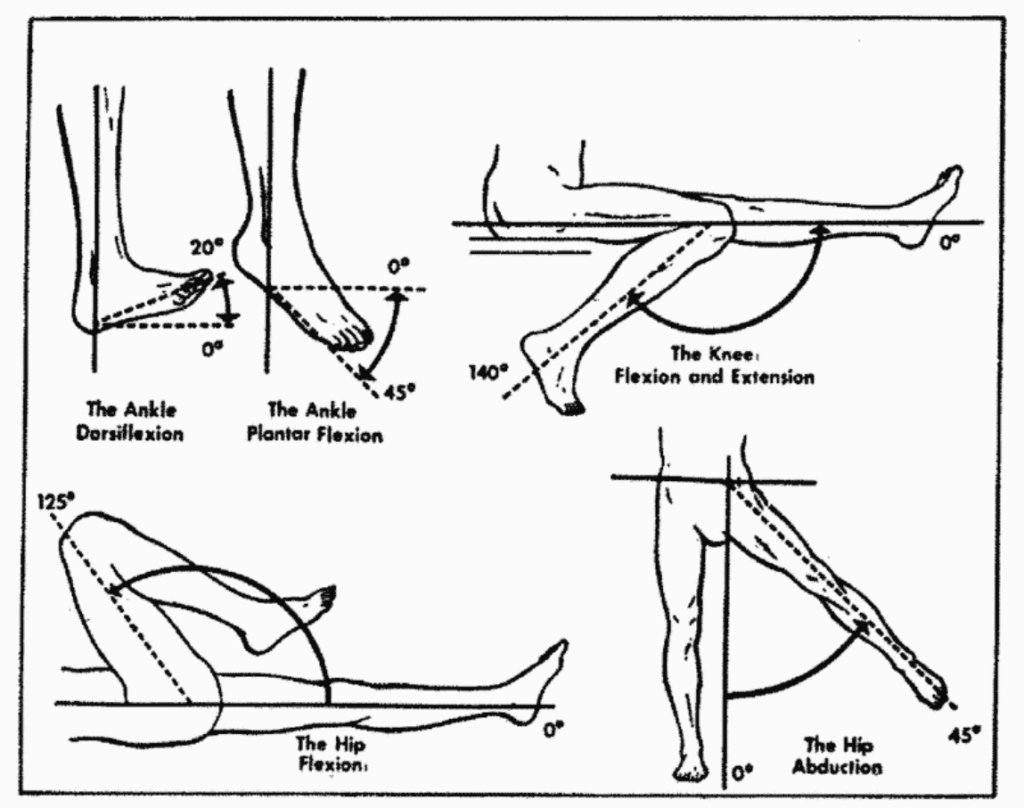Looking for Expert-Level VA Claim Answers?📱Call Us Now! 737-295-2226
In this guide, we’ll explore how to get a VA Rating for Knee Pain even if you’ve already filed, been denied, or gave up.
Limitation of Flexion of the Knee or “Knee Pain” is the #3 most common VA claim.
VA Disability for Knee Pain ranges from 10 percent to 30 percent with an interim break at 20 percent.

The highest schedular rating for knee pain, also called “Limitation of Flexion of the Knee” is 30%, and includes the following symptoms:
- Recurrent subluxation or instability: Unrepaired or failed repair of complete ligament tear causing persistent instability, and a medical provider prescribes both an assistive device (e.g., cane(s), crutch(es), walker) and bracing for ambulation.
Your final VA Disability Rating for Knee Pain depends upon the Frequency, Severity, and Duration of symptoms and any impairment or loss (e.g., negative work and life impacts).
Chronic “Knee Pain” can have considerable debilitating effects on veterans, especially due to the side effects of medications taken to manage your pain, which can lead to a variety of other disabling conditions such as various Orthopedic Conditions, Plantar Fasciitis, Arthritis, GERD and IBS, and Depression and Anxiety.
Thus, it’s possible for to get various conditions service connected Secondary to Knee Pain.
Okay, let’s jump into this Insider’s Guide for getting a service connected disability rating for Knee Pain.
- What is Knee Pain in Veterans?
- Common Signs and Symptoms of Knee Pain
- How to Get a Knee Pain VA Rating: Basic Eligibility Criteria
- VA Knee Disability Rating: Is Knee Pain a VA Disability?
- How Do I Get a VA Rating for Knee Pain?
- What is the Reasonable Doubt Rule for Knee Pain?
- What is the VA Knee Rating Chart?
- What Are Some Common VA Secondary Conditions to Knee Pain?
- What Should I Expect at a VA C&P Exam for Knee Pain?
- About the Author

What is Knee Pain in Veterans?
Knee pain is a very common condition that affects veterans of all ages.
Knee pain may be the result of an injury, such as a ruptured ligament or torn cartilage.
Other medical conditions, such as arthritis, gout, and infections can also cause knee pain.
Minor knee pain usually responds well to self-care measures.
Physical therapy and knee braces also can help relieve pain.
In more serious cases, however, your knee may require surgery.

Common Signs and Symptoms of Knee Pain
According to the Mayo Clinic, symptoms of Knee Pain include:
- Sharp pain
- Swelling
- Stiffness
- Redness
- Warm to the touch
- Weakness
- Instability
- Popping
- Crunching sounds
- Inability to fully extend the knee

How to Get a Knee Pain VA Rating: Basic Eligibility Criteria
To be eligible for a Knee Pain VA Rating, a veteran must meet three (3) criteria by law:
- #1. Medical diagnosis of Knee Pain, in a medical record (Service Treatment Records, VA medical records, or private medical records).
- #2. Your Knee Pain was caused or made worse by your active-duty military service OR by another service connected disability for secondary service connection (“Nexus” for service connection).
- #3. Persistent and recurring symptoms of Knee Pain (“Severity of Symptoms”) in terms of Frequency, Severity, and Duration to include any functional impairment or loss.
If you think you have a knee condition, but don’t have a medical diagnosis, pick-up the phone and call the VA health facility nearest you to make an appointment right away!
If you’re trying to increase your VA disability for knee pain, you need to prove to the VA that your symptoms are now worse and warrant the higher rating criteria by law.
The #1 best way to increase your VA rating for Knee Pain is to have objective medical evidence (X-Ray, MRI results, etc.) to show your symptoms have worsened over time.

VA Knee Disability Rating: Is Knee Pain a VA Disability?
Yes, Knee Pain is a VA disability, and it can be rated at 10%, 20%, or 30% depending on the severity of your symptoms.
The VA rates knee conditions under CFR Title 38, Part 4, Schedule for Rating Disabilities, DC 5257, Knee Impairment.
However, if you have “Unfavorable Ankylosis of the Knee,” it’s rated under DC 5256 instead, which has VA ratings of 30%, 40%, 50%, and 60% depending on the frequency, severity, and duration of symptoms to include limitation of range of motion and functional impairment.

How Do I Get a VA Rating for Knee Pain?
There are 3 primary ways a veteran can get a VA disability rating for Knee Pain:
#1: Direct Service Connection for Knee Pain with a rating of 10%, 20%, or 30%. This means an in-service event, injury, or disease related to your military service caused you to develop Knee Pain.
#2: Secondary Service Connection for Knee Pain with a rating of 10%, 20%, or 30%. For example, a veteran can be rated for Knee Pain secondary to Hip Pain, among others.
#3: Unfavorable Ankylosis of the Knee with a rating of 30%, 40%, 50%, or 60%. Ankylosis of the Knee means you can’t bend it past certain degrees, as measured by a Goniometer.

What is the Reasonable Doubt Rule for Knee Pain?
The reasonable doubt rule, also known as the Benefit of the Doubt Doctrine, means that the evidence provided by the veteran must only persuade the decision maker that each factual matter is “at least as likely as not.”
This means there’s a 50/50 chance.
When, after careful consideration of all evidence, a reasonable doubt arises regarding service origin, the degree of disability, or any other point, such doubt will be resolved in favor of the veteran.
The courts further likened the reasonable doubt rule as akin to the principle in baseball that the “tie goes to the runner.”
When in doubt, the benefit is ALWAYS given to the veteran.
Independent providers and C&P examiners must consider and give weight to the veterans self-reported symptoms when completing their DBQ for Knee Pain.

What is the VA Knee Rating Chart?
The VA knee rating chart is broken out into two separate categories based on “Pain” or “Unfavorable Ankylosis.”
For example, Knee Pain (DC 5257) only has VA ratings of 10%, 20%, or 30% while Unfavorable Ankylosis of the Knee (5256) has VA ratings of 30%, 40%, 50%, or 60%.
VA Rating Chart for Knee Pain:
| DC 5257, Knee Pain: | VA Rating |
| Recurrent subluxation or instability: | |
| Unrepaired or failed repair of complete ligament tear causing persistent instability, and a medical provider prescribes both an assistive device (e.g., cane(s), crutch(es), walker) and bracing for ambulation | 30% |
| One of the following: | |
| (a) Sprain, incomplete ligament tear, or repaired complete ligament tear causing persistent instability, and a medical provider prescribes a brace and/or assistive device (e.g., cane(s), crutch(es), walker) for ambulation. | |
| (b) Unrepaired or failed repair of complete ligament tear causing persistent instability, and a medical provider prescribes either an assistive device (e.g., cane(s), crutch(es), walker) or bracing for ambulation | 20% |
| Sprain, incomplete ligament tear, or complete ligament tear (repaired, unrepaired, or failed repair) causing persistent instability, without a prescription from a medical provider for an assistive device (e.g., cane(s), crutch(es), walker) or bracing for ambulation | 10% |
VA Rating for Unfavorable Ankylosis of the Knee:
| DC 5256, Ankylosis of the Knee: | VA Rating |
| Extremely unfavorable, in flexion at an angle of 45° or more | 60% |
| In flexion between 20° and 45° | 50% |
| In flexion between 10° and 20° | 40% |
| Favorable angle in full extension, or in slight flexion between 0° and 10° | 30% |
Can I Get a VA Rating for Knee Popping?
While there is no specific VA rating for knee popping, the issue puts you at risk for arthritis, which could qualify you for a VA disability rating. The VA rates arthritis of the knee at 20%, 40%, 60%, and 100%, depending on the severity of your condition.

What Are Some Common VA Secondary Conditions to Knee Pain?
It’s possible for your Knee Pain to be caused or made worse by another service connected disability for secondary service connection.
Here’s a list of common Knee Pain secondary conditions:
- Knee Pain secondary to Arthritis
- Knee Pain secondary to Back Conditions
- Knee Pain secondary to Hip Conditions
- Knee Pain secondary to Ankle Conditions
- Knee Pain secondary to Plantar Fasciitis
- Knee Pain secondary to Flat Feet

What Should I Expect at a VA C&P Exam for Knee Pain?
A C&P exam for Knee Pain involves a series of verbal questions, to include a physical examination, and Range of Motion (ROM) test with a Goniometer.
The following are a list of five sections and common questions asked at a VA C&P exam for Knee Pain, based on the DBQ for Knee and Lower Leg conditions.
SECTION I – DIAGNOSIS
1A. List the claimed conditions that pertain to this questionnaire.
1B. Select diagnoses associated with the claimed condition(s) (check all that apply):
SECTION II – MEDICAL HISTORY
2A. Describe the history (including onset and course) of the Veteran’s knee and/or lower leg condition (brief summary).
2B. Does the Veteran report flare-ups of the knee and/or lower leg? If yes, document the Veteran’s description of the flare-ups he/she experiences, including the frequency, duration, characteristics, precipitating and alleviating factors, severity and/or extent of functional impairment he or she experiences during a flare-up of symptoms.
2C. Does the Veteran report having any functional loss or functional impairment of the joint or extremity being evaluated on this questionnaire, including but not limited to after repeated use over time? If yes, document the Veteran’s description of functional loss or functional impairment in his/her own words.
2D. Does the Veteran report or have a history of instability or recurrent subluxation of the knee? If yes, document the Veteran’s description of instability/ recurrent subluxation in his/her own words.
2E. Does the Veteran report or have a history of frequent effusion of the knee? If yes, is the frequent effusion a result of a diagnosis in Section I? Describe below.
SECTION III – RANGE OF MOTION (ROM) AND FUNCTIONAL LIMITATION
There are several separate parameters requested for describing function of a joint. The question “Does this ROM contribute to functional loss?” asks if there is functional loss that can be ascribed to any documented loss of range of motion; and, unlike later questions, does not consider the numerous other factors to be considered.
Subsequent questions consider additional factors such as pain, fatigue, weakness, lack of endurance, or incoordination. If there is pain noted on examination, it is important to understand whether that pain itself contributes to functional loss. Ideally, a claimant would be seen immediately after repetitive use over time or during a flare-up; however, this is not always feasible. Information regarding joint function on repetitive use is broken up into two subsets.
The first subset is based on observed repetitive use, and the second is based on functional loss associated with repeated use over time. The observed repetitive use section initially asks for objective findings after three or more repetitions of range of motion testing.
The second subset provides a more global picture of functional loss associated with repetitive use over time. The latter considers medical probability of additional functional loss as a global view. This considers not only the objective findings noted on the examination, but also the subjective history provided by the claimant, as well as review of the available medical evidence.
Optimally, a description of any additional loss of function should be provided – such as what the degrees of range of motion would be opined to look like after repetitive use over time. However, when this is not feasible, an “as clear as possible” description of that loss should be provided. This same information (minus the three repetitions) is asked to be provided with regards to flare-ups.
Pro Tip: For any joint condition, examiners should address pain on both passive and active motion, and on both weight-bearing and nonweight-bearing. Examiners should also test the contralateral joint (unless medically contraindicated). If testing cannot be performed or is medically contraindicated (such as it may cause the Veteran severe pain or the risk of further injury), an explanation must be given below. Please note any characteristics of pain observed on examination (such as facial expression or wincing on pressure or manipulation).
3A. What are the Initial ROM measurements for right knee and/or left knee?
– If ROM is outside of “normal” range but is normal for the Veteran (for reason other than a knee/lower leg condition, such as age, body habitus, neurologic disease), please describe.
– If abnormal, does the range of motion itself contribute to a functional loss? (If yes, please explain).
– Range of Motion (ROM) test: Perform active and/or passive range of motion and provide the ROM values.
– Did the veteran have pain on ROM? If yes, was it Flexion, Extension, or both?
– If any limitation of motion is specifically attributable to pain, weakness, fatigability, incoordination, or other; please note the degree(s) in which limitation of motion is specifically attributable to the factors identified and describe. If yes, what was the Flexion degree endpoint (if different than above)? If yes, what was the Extension degree endpoint (if different than above)?
– Is there evidence of pain? If yes, check all that apply.
- Weight-bearing
- Nonweight-bearing
- Active motion
- Passive motion
- On rest/non-movement causes functional loss (if checked describe in the comments box below)
- Does not result in/cause functional loss
– Is the Veteran able to perform repetitive-use testing with at least three repetitions? Yes or no.
– Is there additional loss of function or range of motion after three repetitions?
Pro Tip: When pain is associated with movement, the examiner must give a statement on whether pain could significantly limit functional ability during flare-ups and/or after repeated use over time in terms of additional loss of range of motion. In the exam report, the examiner is requested to provide an estimate of decreased range of motion (in degrees) that reflect frequency, duration, and during flare- -ups – even if not directly observed during a flare-up and/or after repeated use over time.
– Select factors that cause this functional loss: (check all that apply)
- Pain
- Fatigability
- Weakness
- Lack of endurance
- Incoordination
- Other (Describe)
– Is the Veteran being examined immediately after repeated use over time? Yes or no.
– Does procured evidence (statements from the Veteran) suggest pain, fatigability, weakness, lack of endurance, or incoordination which significantly limits functional ability with repeated use over time? Yes or no.
– Estimate range of motion in degrees for this joint immediately after repeated use over time based on information procured from relevant sources including the lay statements of the Veteran.
Flexion endpoint (140 degrees): _____ degrees.
Extension endpoint (0 degrees): _____ degrees.
Pro Tip: The examiner should provide the estimated range of motion based on a review of all procurable information – to include the Veteran’s statement on examination, case-specific evidence (to include medical treatment records when applicable and lay evidence), and the examiner’s medical expertise. If, after evaluation of the procurable and assembled data, the examiner determines that it is not feasible to provide this estimate, the examiner should explain why an estimate cannot be provided. The explanation should not be based on an examiner’s shortcomings or a general aversion to offering an estimate on issues not directly observed.
– Please cite and discuss evidence. (Must be specific to the case and based on all procurable evidence).
– Is the examination being conducted during a flare-up? Yes or no.
– Does procured evidence (statements from the Veteran) suggest pain, fatigability, weakness, lack of endurance, or incoordination which significantly limits functional ability with flare-ups? Yes or no.
– Select factors that cause this functional loss. (Check all that apply)
- Pain
- Fatigability
- Weakness
- Lack of endurance
- Incoordination
- Other (Describe)
– Estimate range of motion in degrees for this joint during flare-ups based on information procured from relevant sources including the lay statements of the veteran.
Flexion endpoint (140 degrees): _____ degrees.
Extension endpoint (0 degrees): _____ degrees.
Pro Tip: The examiner should provide the estimated range of motion based on a review of all procurable information – to include the Veteran’s statement on examination, case-specific evidence (to include medical treatment records when applicable and lay evidence), and the examiner’s medical expertise. If, after evaluation of the procurable and assembled data, the examiner determines that it is not feasible to provide this estimate, the examiner should explain why an estimate cannot be provided. The explanation should not be based on an examiner’s shortcomings or a general aversion to offering an estimate on issues not directly observed.
– Please cite and discuss evidence. (Must be specific to the case and based on all procurable evidence.)
– In addition to those addressed above, are there additional contributing factors of disability? Please select all that apply and describe:
- None
- More movement than normal (indicate if there is nonunion of fracture)
- Weakened movement
- Less movement than normal
- Swelling
- Deformity
- Atrophy of disuse
- Instability of station
- Disturbance of locomotion
- Interference with sitting Interference with standing
- Other, describe
SECTION IV – MUSCLE ATROPHY
4A. Does the Veteran have muscle atrophy? Yes or no.
4B. If yes, is the muscle atrophy due to the claimed condition in the diagnosis section? If no, provide rationale.
4C. For any muscle atrophy due to a diagnosis listed in Section I, indicate specific location of atrophy, providing measurements in centimeters of normal side and corresponding atrophied side, measured at maximum muscle bulk.
Right lower extremity (specify location of measurement such as “10cm above or below the knee”):
Circumference of more normal side: _____ cm.
Circumference of atrophied side: _____ cm.
SECTION V – ANKYLOSIS
Pro Tip: Ankylosis is the immobilization of a joint due to disease, injury, or surgical procedure.
5A. Is there ankylosis of the knee and/or lower leg? If yes, indicate the severity of ankylosis.
Favorable angle in full extension or in slight flexion between 0 and 10 degrees
- In flexion between 10 and 20 degrees
- Favorable angle in full extension or in slight flexion between 0 and 10 degrees
- In flexion between 10 and 20 degrees 5B
- In flexion between 20 and 45 degrees
- Extremely unfavorable, in flexion at an angle of 45 degrees or more
- N/A no ankylosis of knee joint
5B. Indicate angle of ankylosis in degrees: _____ degrees.
5C. If ankylosed, is there involvement of Muscle Group XIII (posterior thigh group, hamstring complex of 2-joint muscles: (1) biceps femoris; (2) semimembranosus; (3) semitendinosus)? If yes, the examiner must complete the Muscle Injuries questionnaire.
About the Author

Brian Reese
Brian Reese is a world-renowned VA disability benefits expert and the #1 bestselling author of VA Claim Secrets and You Deserve It. Motivated by his own frustration with the VA claim process, Brian founded VA Claims Insider to help disabled veterans secure their VA disability compensation faster, regardless of their past struggles with the VA. Since 2013, he has positively impacted the lives of over 10 million military, veterans, and their families.
A former active-duty Air Force officer, Brian has extensive experience leading diverse teams in challenging international environments, including a combat tour in Afghanistan in 2011 supporting Operation ENDURING FREEDOM.
Brian is a Distinguished Graduate of Management from the United States Air Force Academy and earned his MBA from Oklahoma State University’s Spears School of Business, where he was a National Honor Scholar, ranking in the top 1% of his class.



